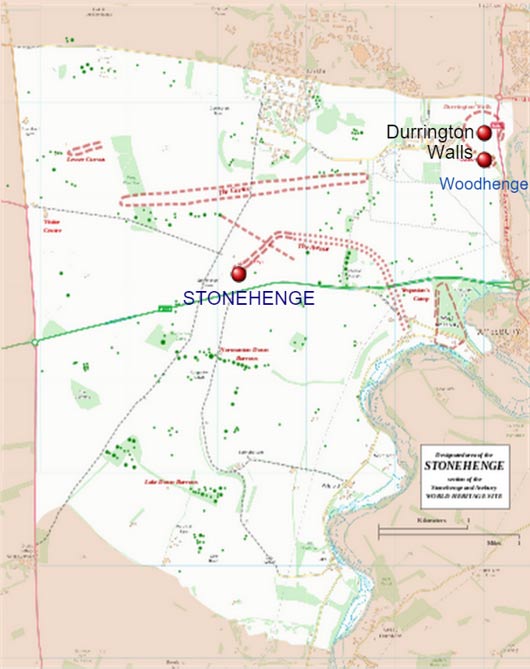
Feeding Stonehenge: Hearty Menu for Monument Builders Revealed - Barbeque Pork, Roast Beef, Yogurt and Cheeses
Remnants of delicious barbeque-style feasts at a major Neolithic settlement in the UK have revealed that pork roasts, milk, yogurt and cheeses were on the menu for the prehistoric builders of Stonehenge. The wealth of foods brought in from afar show that the feasts had both ritual and social significance, and indicate that the builders weren’t slaves forced into work.
The food choices and eating habits of the people at a prehistoric site near Stonehenge have been revealed by the discovery of animal bones and pottery fragments. The prehistoric site, Durrington Walls, is a Late Neolithic settlement believed to be the nearby residence for the builders of the Stonehenge stone monument during the 2500 BC, according to a press release from the University of York.
- Major Discovery: 4,500-year-old megalithic super-henge found buried one mile from Stonehenge
- New Scans of Ancient Pompeii Victims Reveal Great Teeth and Good Health
- Stone Age people were eating porridge 32,000 years ago

Stonehenge, Whiltshire, England. (Diego Delso/ CC BY-SA 3.0)
The research team comprised of archaeologists from the University of York, University College London (UCL), and University of Sheffield in UK unearthed evidence of mass animal consumption, especially pig, as well as beef and varied dairy products.
Far from seeming to be a slave-based society where labor was coerced, as has been speculated in past, the new evidence points to “organized feasts featuring barbeque-style roasting,” and a well-fed population.
Barbeque Meat Fest
Remains from animals were unearthed, many of them were killed before reaching full growth, providing compelling evidence of a feast which was planned for autumn and winter.
As the complete skeletons were present, the animals are thought to have been walked to the site and then slaughtered, rather than being butchered remotely and carried in as joints of meat. Cattle had come from many different locations across Britain, some far away. There were distinctive burn markings on some of the animal bones showing they were roasted on a fire outdoors, while other cooking methods included boiling in pots in indoor hearths.
It is believed all this would require many volunteers to organize the logistics of bringing in the food and animals.

Detail, Part of several hundred found pottery sherds from Durrington Wall. It is marked as "The Beasts Wife" by archaeologists. (CC BY-SA 3.0)
UCL reports that dairy products, such as cottage cheese, yogurt and curds-and-whey were detected in residues in pots across the site. Dairy foods were present more frequently in ceremonial monuments, indicating they held a significant status. Researchers believe these might have marked social status or were symbols of purity consumed during public ceremonies.
Little evidence of plant-based meals were located at the site. Researchers found the burnt remains of nuts and wild fruits such as berries or crab apples, but no cooking greens or vegetables were located at what is described as a “meat fest”.
- Body of 4,000-year-old teenager near Stonehenge may give clues about Bronze Age lives
- Radar finds HUNDREDS more megalithic monuments, chapels, and shrines around Stonehenge
Community Organization
The origins and types of foods prepared at the prehistoric settlement has given archaeologists “insight into the organization of large-scale feasting among the people who built Stonehenge,” says Professor Mike Parker Pearson, UCL Institute of Archaeology and Director of the Feeding Stonehenge project.
“The special placing of milk pots at the larger ceremonial buildings reveals that certain products had a ritual significance beyond that of nutrition alone. The sharing of food had religious as well as social connotations for promoting unity among Britain’s scattered farming communities in prehistory,” said Pearson.
Lead author of the study published in the journal Antiquity, Dr. Oliver E. Craig said, “Evidence of food-sharing and activity-zoning at Durrington Walls shows a greater degree of culinary organization than was expected for this period of British prehistory. The inhabitants and many visitors to this site possessed a shared understanding of how foods should be prepared, consumed and disposed. This, together with evidence of feasting, suggests Durrington Walls was a well-organized working community,” reports the University of York.
Durrington Walls

Sunrise at the Durrington Walls reconstruction. (Creative Commons Fair Use)
The Neolithic settlement of Durrington Walls is located around 2 miles (3 kilometers) north-east of the famous prehistoric monument Stonehenge. It is thought to have been home to the builders around 2500 BC.

Map showing Durrington Walls and Stonehenge at the Avebury World Heritage Site. (Contains Ordnance Survey data © Crown copyright and database right / CC BY 3.0)
Durrington Walls had monumental standing stone wall reaching up to 30 feet (nine meters) high, as well as circles of wood. Excavations have revealed seven houses, but it’s believed there was room for as many as 1,000 houses judging by the size of the walled enclosure. For a brief period it may have been the largest village in northern Europe.
MailOnline reports there are a few vital differences between the two prehistoric sites; Durrington Walls was a place of habitation and feasting, and Stonehenge wasn’t. Stonehenge has only offered up 11 pot fragments, while more than 11,000 sherds have been found at Durrington.
- Would you enjoy this 4,000-year-old Hittite feast?
- Mummy hair reveals ancient Peruvians enjoyed seafood and beer
The extraordinary Durrington site continues to surprise researchers after a major discovery this year when an enormous row of 90 megalithic stones was found buried beneath the earthworks. A huge line of megalithic stones sits three feet underground and was discovered through the use of sophisticated radar equipment.

The lush landscape of the prehistoric Durrington Walls site. (Public Domain)
The unexpected archaeological finds at Durrington Walls are fleshing out the lives and diets of prehistoric Britains, providing a detailed picture of the beliefs, cuisines, and architecture of the past.
Featured Image: A reconstruction depicting how the row of megalithic stones would have looked. Credit: Ludwig Boltzmann Institute.
By Liz Leafloor














